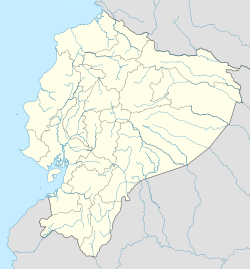Portoviejo | |
|---|---|
| San Gregorio de Portoviejo | |
 From top, left to right: Vicente Amador Flor Central Park, Metropolitan Cathedral of Jesus the Good Shepherd, Eloy Alfaro monument, Olmedo street, Manabi Agriculture monument, Portoviejo Botanical Garden and Manabi Technical University. | |
| Motto(s): Spanish:Portoviejo se Levanta Querer es Poder (English:Portoviejo rises, When there's a will there's a way) | |
| Coordinates: 1°3′22″S 80°27′19″W / 1.05611°S 80.45528°W | |
| Country | |
| Province | Manabí |
| Canton | Portoviejo |
| Founded | March 12, 1535 |
| Founded by | Francisco Pacheco |
| Urban parishes | List of parishes
|
| Government | |
| • Mayor | Javier Pincay |
| • Vice Mayor | Mariela Coral |
| Area | |
• City | 67.94 km2 (26.23 sq mi) |
| Elevation | 53 m (174 ft) |
| Population (2022 census)[1] | |
• City | 244,129 |
| • Density | 3,600/km2 (9,300/sq mi) |
| Time zone | UTC−5 (ECT) |
| Postal code | EC130105 |
| Area code | 593 5 |
| ISO 3166 code | EC-M |
| Climate | BSh |
| Website | www |
Portoviejo (Spanish pronunciation: [poɾtoˈβjexo]), also known as San Gregorio de Portoviejo, is a city in Ecuador, and the capital of the Province of Manabí 30 km (19 mi) from the Pacific coast. It is still known as the city of the "Royal Tamarind Trees" due to former Tamarind plantations in the area.
It serves as the main political and economical centre of the Portoviejo River valley, which also includes the cantons of Santa Ana and Rocafuerte, where about 110 km2 (42 square miles) are cultivated every year.
The city, which was affected by economic crisis in the eighties and nineties, is now recovering but severe budget limitations and a huge unemployment rate present difficulties for local authorities.[2]
Founded on March 12, 1535, it is one of the oldest cities in Ecuador and is the eighth largest of the country.
Portoviejo is important for the cultivation of coffee, cattle and fishing and has a thriving agricultural-processing industry, with good road connections to Quito and Guayaquil.
- ^ Citypopulation.de Population and area of Portoviejo
- ^ "Portoviejo guide, travel destinations & best time to visit | Ecuador". Ecuador.com. Retrieved 2022-09-29.


